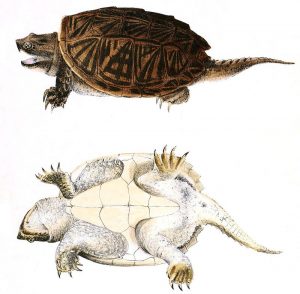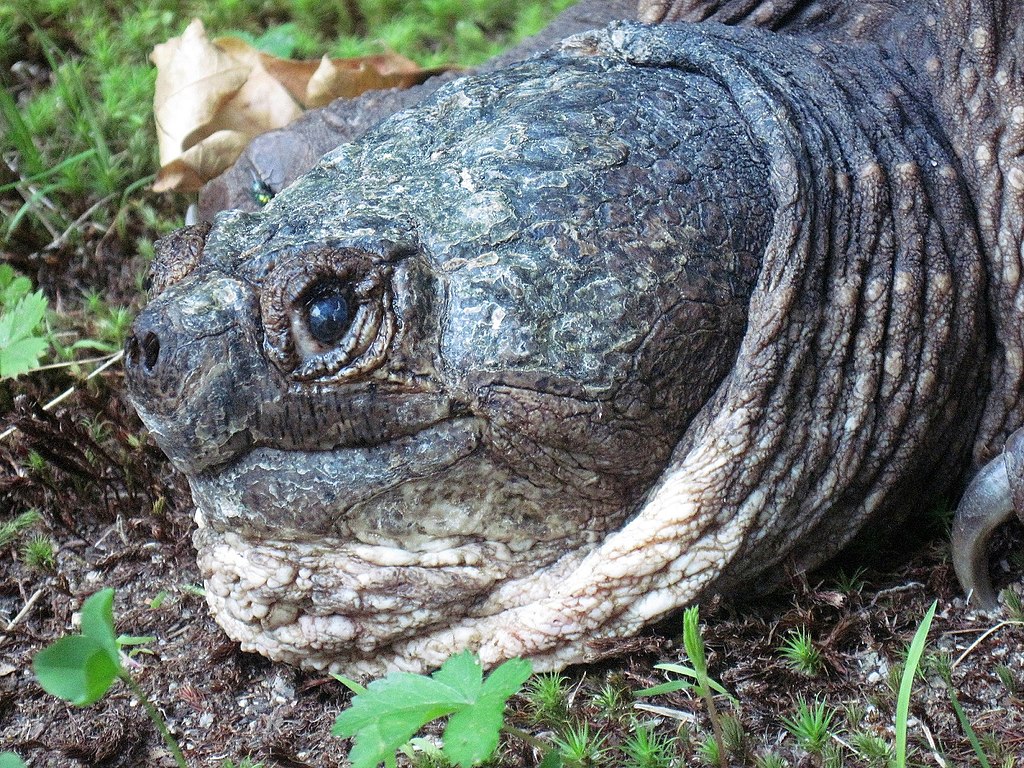By Snappin’ Jack MacRae
It’s not too difficult to find a few big old snapping turtles in January and February if you know where to look (under the ice), and have an adventurous streak. Warm clothes are a bonus.
During the winter, when local ectothermic animals (e.g., amphibians and reptiles) are undergoing hibernation (or, brumation if you want to be a  know-it-all*), these rugged turtles are often alert and mobile – albeit sluggishly – under the ice of our ponds, floodplains, and wetlands.
know-it-all*), these rugged turtles are often alert and mobile – albeit sluggishly – under the ice of our ponds, floodplains, and wetlands.
During summer snappers use their lungs to take slow breaths of good marshy air. By early November and continuing until spring, the turtles will stay beneath the surface absorbing most of their required oxygen directly from the frigid water through the highly vascularized skin near their cloaca.
Finding Yertle
Ice turtles aren’t too hard to find. Most retention ponds, golf course water hazards, and park district fishing ponds in the Fox River’s watershed contain snappers. It is not necessary to head into our pristine natural areas to find them under the ice. In fact, it is often easier and safer to move along the edge of a small manicured pond than the edge of a meandering creek.
The more sun and less snow increases your chance of seeing turtles under the ice. The surface of the ice should be free of snow. The frozen water must be clear enough to see the pond bottom. The best method is to slowly walk the warm, sunlit shoreline (the north shore gets more sun than south shore in winter, the east shore gets more afternoon sun), your eyes focused on the shallow dark water under the ice.Try to see the gently waving leaves of the aquatic vegetation. The more sun that illuminates the water, the better.
Many small public ponds have various pipes and drains to manage the water levels. It seems turtles under the ice may be attracted to these spaces with slightly flowing water.
Look but don’t touch!
 Can a snapping turtle bite off a finger or two? Whit Gibbons of the Savannah River Ecology Laboratory at the University of Georgia says: “Common snapping turtles, which sometimes reach more than 30 pounds, can bite a person and even leave a memorable scar.” But the largest snappers can easily amputate body parts!
Can a snapping turtle bite off a finger or two? Whit Gibbons of the Savannah River Ecology Laboratory at the University of Georgia says: “Common snapping turtles, which sometimes reach more than 30 pounds, can bite a person and even leave a memorable scar.” But the largest snappers can easily amputate body parts!
I once found a snapper frozen solid in the ice in the middle of a Will County pond. I checked it for 3 days. It blinked hello each time. It snowed on the 4th day and the pond was covered. I have no doubt the turtle could have survived the duration of winter.
* Technically, the term hibernation is specific to endothermic animals (birds and mammals) and brumation is used for ectotherms.


Great article – thank you!